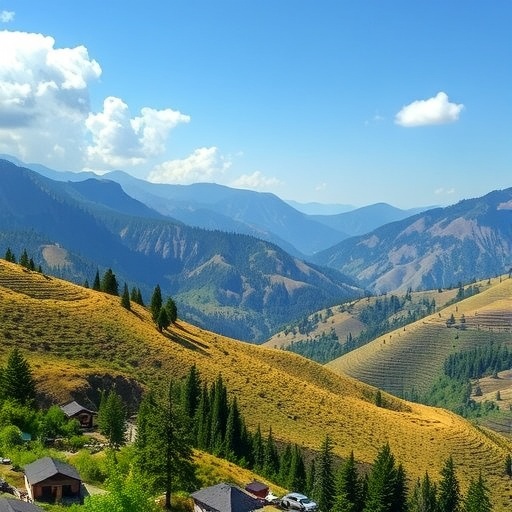In the dynamic world of environmental science, the urgency of addressing land degradation is more critical than ever. Recent research spearheaded by Molla, Ren, and Zuo, published in the journal Environmental Monitoring and Assessment, has taken a keen look at the UN Sustainable Development Goal (SDG) indicator 15.3.1, aiming to provide a robust framework for monitoring land degradation specifically in mountainous regions. The importance of this research stems from the integral role mountains play in global ecosystems, biodiversity, and the livelihood of countless communities.
Mountains, often described as the “water towers of the world,” harbor diverse ecosystems that are vital for human survival. However, these ecosystems face increasing pressures from climate change, urbanization, and unsustainable agricultural practices. The research conducted by Molla and colleagues highlights the urgent need to monitor and evaluate land degradation effectively, especially in mountainous areas, to ensure the sustainable use of these critical lands. The overarching goal of SDG 15 is to protect, restore, and promote sustainable use of terrestrial ecosystems, and indicators like 15.3.1 are essential for tracking progress towards this goal.
The researchers meticulously assessed various methods for measuring land degradation, particularly focusing on the intricacies of mountainous terrains. It’s crucial to adapt existing indicators to reflect the unique challenges and characteristics associated with mountainous regions. Land degradation in these areas often manifests differently than in flat terrains, which necessitates specialized approaches to accurately capture the extent and implications of such degradation.
One of the vital aspects of this research is the integration of remote sensing technology and ground-based measurements. Remote sensing offers a broad perspective, allowing researchers to analyze changes in land use and cover over large areas efficiently. The use of satellite imagery enables them to track shifts in vegetation cover, soil health, and hydrological patterns—key elements that indicate land degradation. Coupled with ground-based data, which provides detailed local insights, this dual approach forms a comprehensive monitoring framework.
Moreover, the paper delves into the socio-economic dimensions of land degradation. It’s not merely an environmental issue; the degradation of land impacts communities that rely on these natural resources for their livelihoods. Understanding the interplay between environmental degradation and socio-economic factors is fundamental to crafting effective policies and interventions. The authors present compelling evidence that highlights the necessity of engaging local communities in monitoring efforts to ensure that their knowledge and experiences are incorporated into assessment frameworks.
The implications of land degradation extend beyond local communities; they resonate globally. The loss of biodiversity, shifts in water availability, and increased vulnerability to climate change are challenges that can have far-reaching effects. Molla et al. emphasize the need for global cooperation and data sharing to combat these challenges collectively. Through comprehensive data sets and monitoring strategies, nations can align their efforts towards achieving the SDGs, ensuring the sustainability of mountainous ecosystems worldwide.
An innovative aspect of the research lies in its application of machine learning and data analytics. By processing vast amounts of environmental data, these technologies can uncover patterns and trends that traditional methods might overlook. The integration of these advanced technologies into land degradation assessments not only enhances accuracy but also allows for real-time monitoring, which is critical for timely interventions.
Additionally, the study evaluates the effectiveness of existing policies and initiatives aimed at mitigating land degradation. It scrutinizes their successes and failures, drawing lessons that can be instrumental for future strategies. The authors argue that creating adaptive and resilient policies is essential in facing the evolving challenges posed by land degradation, particularly in light of shifting climate patterns.
Molla and his team also call for increased investment in research and education around sustainable land management practices. By fostering a deeper understanding of the complex dynamics at play, stakeholders can forge more effective strategies for land conservation. This education is essential not only for policymakers but also for local communities, who are often on the frontline of land degradation challenges.
The research demonstrates a commitment to a multi-disciplinary approach, incorporating insights from ecology, sociology, economics, and technology. Such integrative research is critical in addressing the multifaceted challenge of land degradation. It underscores the necessity for collaboration across various fields to foster innovative solutions that address environmental challenges holistically.
In conclusion, the work of Molla, Ren, and Zuo offers a significant contribution to the understanding and monitoring of land degradation, particularly within mountainous regions. By advancing methodologies aligned with the UN SDGs, the research paves the way for better resource management and environmental stewardship. As the global community grapples with the consequences of land degradation, studies like this are vital in guiding actionable solutions that can mitigate adverse impacts on both local and global scales.
As we move forward, it is paramount that the findings from this research inspire further exploration and implementation of effective monitoring systems. The delicate balance of our mountainous ecosystems must be preserved, not just for the future of those who inhabit these areas, but for the health of our planet as a whole. The journey toward sustainable development is ongoing, and every step we take in understanding and mitigating land degradation brings us closer to a resilient and sustainable future.
Subject of Research: Evaluation of UN Sustainable Development Goal (SDG) Indicator 15.3.1 and Land Degradation Monitoring Methods in Mountainous Regions
Article Title: Evaluating UN sustainable development goal (SDG) indicator 15.3.1 and methods for land degradation monitoring in mountainous regions
Article References:
Molla, A., Ren, Y., Zuo, S. et al. Evaluating UN sustainable development goal (SDG) indicator 15.3.1 and methods for land degradation monitoring in mountainous regions. Environ Monit Assess 197, 1098 (2025). https://doi.org/10.1007/s10661-025-14548-8
Image Credits: AI Generated
DOI: 10.1007/s10661-025-14548-8
Keywords: land degradation, sustainability, mountainous regions, UN SDG 15, remote sensing, machine learning, socio-economic impact, environmental policy




